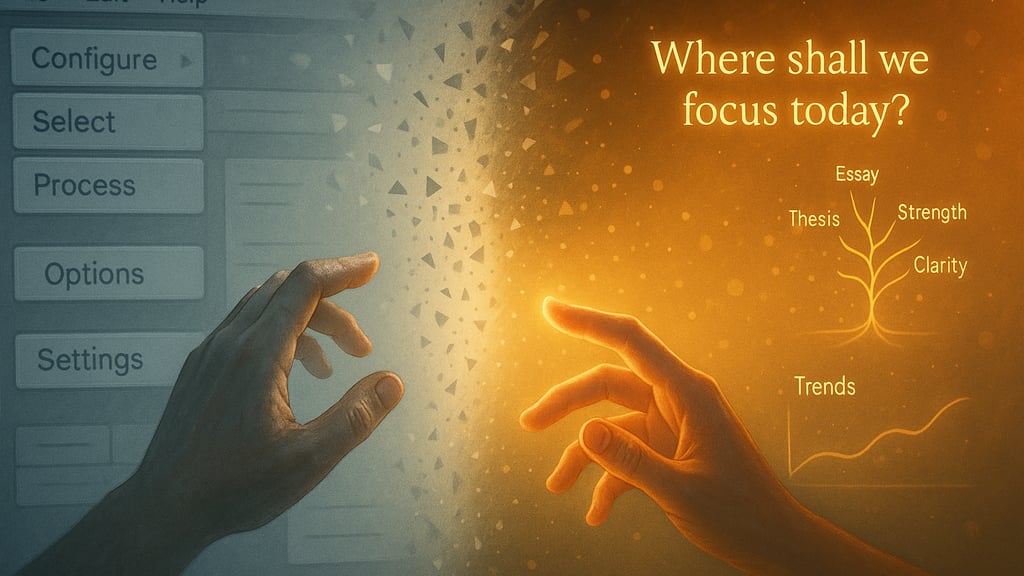From Menus to Meaning: Embracing the Shift to Intent-Driven Systems
Blog post description.Before you read this, make sure you read Michael Carroll's article first: The Latency Trap – SaaS’s Silent Sabotage – https://lnkd.in/gxqJ44i8 Let us be the ones who stop navigating menus and start defining meaning. Let us demand software that doesn't just record our actions but understands our goals
Matthew Alberts, PhD, Michael Carroll
8/23/20253 min read


The portrait of Betty, her chalk-stained hands hovering over a keyboard, her purpose diluted by a labyrinth of dropdown menus, is not just a powerful anecdote, it is a hauntingly accurate allegory for the modern professional experience. The article, The Latency Trap: SaaS’s Silent Sabotage by Michael Carroll , masterfully diagnoses a disease that has infected not just education, but every industry: the prioritization of data transactions over human intention.
We agree wholeheartedly. The SaaS architecture, built on the bedrock of CRUD operations, was a necessary evolution from the siloed, on-premise servers of the past. But as the article so rightly argues, its triumph of scalability has become a straitjacket of cognitive tax. The "navigational cost" is real; it is the silent thief of focus, creativity, and progress, measured not in seconds but in squandered potential.
The question the article so compellingly raises is not if this is a problem, but what we do about it. If the old paradigm values control, and the new one values cognition, how do we, as individuals, teams, and organizations, become architects of the latter?
The answer lies in recognizing that the shift to agentic reasoning is not a distant, abstract future to be waited for. It is a principle we can begin to integrate into our mindset and our demands today. It starts with a simple but profound change: we must stop seeing software as a tool we use and start demanding it become a partner we collaborate with.
1. We Must Become Inquisitive About Our Own Friction.
The first step toward empowerment is awareness. Betty knew the system felt wrong; she felt the friction in her bones. We must become students of our own frustration. Every time we sigh before clicking through five screens to complete one logical task, we should ask: "What is the human goal here? How could this intent be understood, not just processed?" This isn't just complaining; it is the essential first step of user-led innovation. Document these moments. Share them. They are the raw requirements for a better system.
2. We Can Champion "Intent Interfaces" Over "Menu Interfaces."
The article brilliantly contrasts the menu-driven present with the agentic future. But what does that look like in practice? It means advocating for interfaces that begin with a question or a hypothesis, not a blank form.
Instead of a grading module with tabs and dropdowns, imagine a dashboard that says: "Your Class Analysis: Essays show strong thematic understanding but 40% struggle with sentence structure. Review targeted feedback for these three students?"
Instead of a factory floor system demanding data entry, imagine an alert that says: "Machine 5 shows a vibration pattern 95% correlated with future bearing failure. Schedule maintenance within 48 hours? I’ve already provisioned the part."
This is not science fiction; it is the application of existing AI and edge computing principles with a clear, human-centric purpose. We empower ourselves by demanding that our tools present insights, not just forms.
3. We Can Build a Coalition for Cognitive Liberation.
The disadvantage for SaaS-bound companies is exponential, as the article notes. This creates a powerful business imperative. We, the users—the teachers, the operators, the managers—are not powerless. We are the source of the productivity that these systems are meant to enable. We must become vocal advocates within our organizations for solutions that reduce cognitive overhead. Frame it not as a desire for "shiny new tech," but as a critical strategy to:
Recapture Latency: Convert wasted minutes into meaningful work.
Eliminate Intermediation: Free highly-skilled people from being glorified data clerks so they can do what only humans can do—think, create, and empathize.
Capture Emergence: Solve problems before they happen, turning risk into advantage.
The referenced McKinsey study shows the staggering cost of inaction. Use that data. Make the case that agentic principles are a competitive necessity.
The True Enlightenment: The Future is a Dialogue
The most enlightening perspective we can adopt is that the future of technology is not autonomous; it is symbiotic. Agentic reasoning does not seek to replace Betty; it seeks to amplify her. It handles the administrative burden of grading so she can focus on the nuanced art of teaching. It manages the data logging so the factory operator can focus on optimizing the production line.
The dragon of menu-driven software, as the article suggests, is indeed hoarding our time and potential. But the courageous act is not merely to slay it. It is to build a new kingdom in its place—one where our tools are built not around the structure of a database, but around the brilliance of human intent.
The call to action is clear. Let us be the ones who stop navigating menus and start defining meaning. Let us demand software that doesn't just record our actions but understands our goals. Let us empower ourselves to build, adopt, and champion systems that are not adversaries, but partners in progress. The architecture of the future awaits its most crucial component: us.
